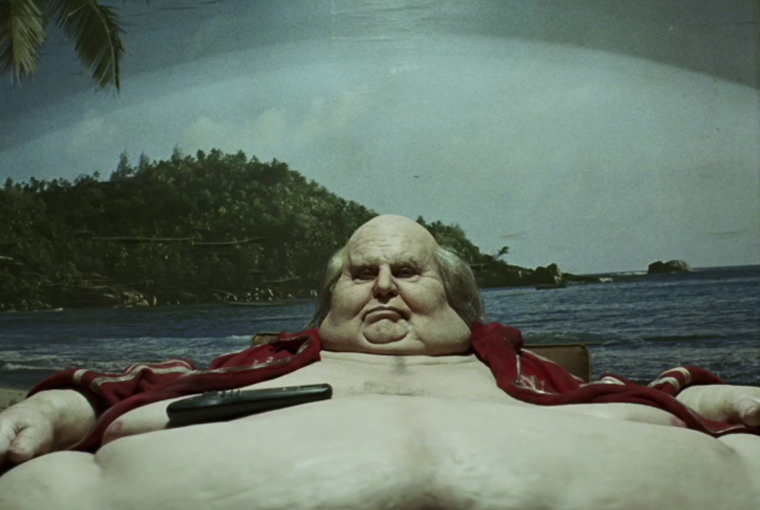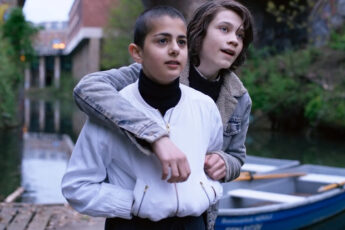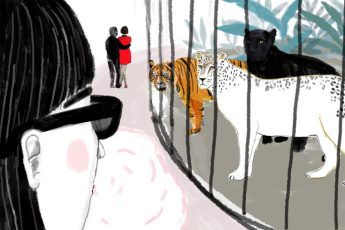Three Generations, Three Eras, Three Sins
György Pálfi’s Taxidermia (2006)
Vol. 31 (July 2013) by Ana Ribeiro
Taxidermia is Hungarian filmmaker’s Gyorgy Pálfi’s second feature film. Grandfather, father, son. War, communism, post-communism. Lust, gluttony, vanity. Three generations, three eras, three sins. All tales wrapped up in surrealism and scatology. To each generation corresponds one era, to each era, one sin. To each of the three parts, punishments. The film is introduced by a voice-over that ends with the following statement: “If something is coming to an end, then its beginning is also important”. We are soon to discover the beginning of the story of these three damned generations which are entranced in Hungarian History.
And then begins the story of Morosgoványi, an isolated soldier in a detached camp, living with his superior officer and his family. Submitted to humiliating tasks, this man seems to have only one thing in mind, one thing to escape reality: sex. Sexual fantasies. But sex here has nothing to do with beauty or love.
Morosgoványi finds pleasure in pain; he is not a handsome man, yet his penis is often shown. As are his body fluids, to be euphemistic. When he finally manages to execute his wish; he has sex with the obese and unattractive officer’s wife (indeed, it wouldn’t make sense to describe their act as “making love”). They do it on the slaughtered corpse of a pig, clothes on, perspiring, genitals explicitly shown. The wife calls this soldier “My little pig”, a sign of tenderness.
The slaughtered pig can be seen as symbol. It is destructed, dismembered, like a country – and the people inside it – during and after a war. This disgusting animal doesn’t seem to bother Morosgoványi though – he finds pleasure in spite of, or, perhaps, in the destruction, in the ugliness that is so similar to the desolate ambiance he has been living in.
But the soldier is punished for his sin of lust. Once the officer finds out about it, he kills his subordinate. However, the story is only beginning, and another generation is yet to come. The sexual relationship between Morosgoványi and the officer’s wife gives birth to Kálman, who is surrealistically born with a pig’s tail. He is raised by the officer, Balatony, and his wife, as their son.
So we arrive at the second generation. The story of Kálman takes place during communist times. He has become a champion of food competitions, or “sport eating”, as his entourage prefers to call it, and intends to make it into an Olympic category, searching for recognition. There is a love story here, between Kálman and Gizela, another sport eating champion, that, nevertheless, doesn’t set aside a little touch of cheating: Gizela cheats on Kálman on their wedding night. However, they seem to live happily ever after – or almost, as we’ll see later.
Scatology, in its turn, is even more present than in the first part. The sport eating competitors are constantly vomiting, and the “results” are always shown. But another important question is raised.
Was communism really communism for everybody? The food competitions can be seen in different ways: the most obvious perspective is how these events reflect the power of the communist food industry, and how well the system could nourish their people. But there is another take on the matter: are we witnessing a case of capitalist mentality within the communist system? After all, the food there is not being used to fulfill hunger or give some kind of pleasure. It is useless consumption of food, something essential, and in many cases surreptitiously rationed during communist times. The goal is not to nourish anyone, but to win such competitions.
Although Kálman end Gizela are perfect communist “sportsmen,” another point shows that the regime in Hungary wasn’t completely satisfying even for them: they dream about going to Norway. The couple is then punished for their sin of gluttony. Gizela gives birth to an unattractively skinny baby, Lajos, who becomes a skinny man, despite their efforts.
This is the third and last generation of Pálfi’s story. Lajos is a taxidermist. He spends his days at work, taking care of his more than morbidly obese father. Here we can see that Kálman’s punishment went way further than having a skinny son. He was left behind by Gizela, who became a coach in sport eating in the USA, now a popular show in America. He is obsessed by training cats in sport eating, and it’s up to Lajos to provide for his father’s passion. Nonetheless, Kálman still despises his son, despite all the efforts of the latter.
One day, Lajos decides to leave his abusive father, who spends his days sitting at home, swallowing “Champion” chocolate bars wrapped up in paper, and going to the gym, desperately (and unsuccessfully) trying to build up his body. But soon, Lajos is overcome by guilt and returns home. He finds his father dead, with his guts blow up and his entrails intertangled with the remains of the chocolate bars that his cats are feeding on.
Then the film goes into a surrealistic, sci-fi, scatological mode. Lajos decides to put his taxidermist skills to the test and attempt to improve his own body. Here’s the vanity speaking out loud. Using a self-made machine, he mixes his father’s “optimized” organs with his own body, like a modern Dr. Frankenstein. However, something goes wrong, and his punishment is capital.
A client finds Lajos’ laboratory and takes advantage of what he finds in there. He transforms Lajos’ craziness into museum pieces. Finally, we understand the voice-over in the beginning. It was actually part of the client’s speech during the gallery opening. As the film ends, we hear him say: “There are things that are important for different people. For some it’s space, for others, it’s time”.
Would Lajos’ experiment extend his time in this world? Would he be in search of immortality? Or is that only the client’s opinion? These are just some of the many questions Pálfi’s film raises. Like it or not, if your stomach turns with it or not.




Leave a Comment